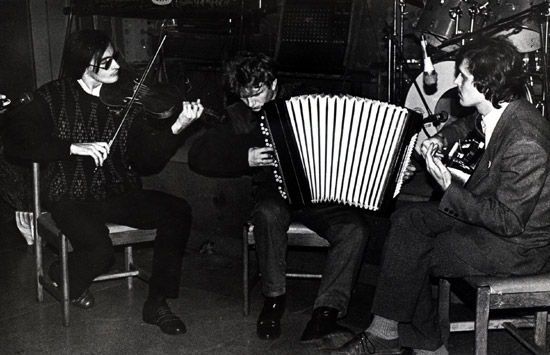The northernmost nation along the Black Sea, and one of seven countries into which the Carpathian Mountains extend, Eastern European Ukraine is the second-largest nation in Europe. Bordered by seven countries, it has a history of being taken over many times, resulting in its multicultural heritage. Polish and Russian influence have been especially strong, with areas of Ukraine being a part of both Poland and the Russian Empire before the whole land was eventually absorbed into the Soviet Union. Notable Ukrainian musicians have been sent to serve in the royal courts of Poland and Russia.
Suppression and Heroism
The Soviet era resulted in a significant change in music that all of the Soviet Republics experienced. Socialist realism was instilled as the official art style of Ukraine, and remained as such for almost six decades. The tradition of the kobzari—blind, kobza-playing Cossack minstrels—more or less came to an end during Stalin’s purges of the 1930s. Additionally, religious music and many forms of classical music were disapproved of, and such performances were suppressed. A tradition of realistic, optimistic, heroic proletarianism was instilled across the Soviet Union, resulting in work songs that became the new folk music of Ukraine. A significant song that Ukraine borrowed from Russia is “На сопках Маньчжурии" ("Na sopkah Manchzhurii," or "The Hills of Manchuria"), which refers to the Battle of Mukden of the Russo-Japanese War.
Poland’s influence is also apparent in Ukrainian musical tradition, particularly in a specific subgenre of classical music. That subgenre consists of non-Ukrainian composers active within Ukraine, primarily inspired by Polish and Russian texts. The Polish polonoise waltz has its origins in the ceremonial folk dances of weddings and balls, and was eventually adopted into the Ukrainian repertoire.
The Klezmer Tradition
Jewish presence within Ukraine has resulted in a two-way exchange of musical forms. During the early 1800s, Jewish people were confined to a specific region within Imperial Russia (the Pale of Settlement)—part of which extended into Ukraine—resulting in the introduction of klezmer music. Klezmorim—professional klezmer musicians—traditionally played dance music for weddings and other celebrations. Until 1855, Jewish musicians were not allowed to play loud instruments, restricting klezmorim to quiet instruments such as the fiddle, tsimbl (a hammered dulcimer), and flute. Ensemble sizes and concerts were also restricted, resulting in further difficulties for the genre. The instruments favored in klezmer music are those that can be easily moved around, making clarinets, violins, trumpets, accordions, tsimbls, and drums more popular than cellos, pianos, and large bass instruments.
While klezmer music maintains a presence in Ukraine, Ukrainian music came to represent a significant portion of klezmer songs, and the influence didn’t stop there. Other Jewish music, including the wedding song “Hava Nagila,” were influenced by Ukrainian instrumentation and dance music.
For all its rich and varied musical heritage, there is no questioning the national Ukrainian instrument. The bandura—the descendent of the kobza that resembles a cross between a zither and a lute—is cherished as the “voice of the Ukrainian people.”
Article written for World Trade Press by Cam Waller.
Copyright © 1993-2025 World Trade Press. All rights reserved.




